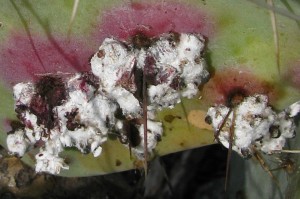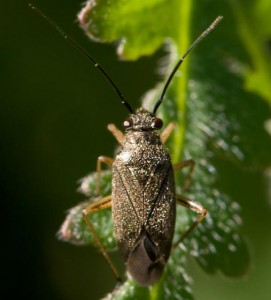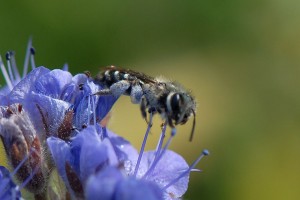We have nine new additions to the BFS invert list:
- Dactylopius sp. (Cochineal)
Our first addition is an insect that any casual observer might notice at the BFS, but it had somehow been overlooked in our list making – Cochineal (Dactylopius sp.) – that white cottony stuff on Opuntia sp. cacti (Prickly-Pear or Indian-Fig):Dactylopius sp. are the source of the red dyes cochineal and carmine. Although these dyes have largely been replaced by synthetic organics for dyeing cloth, they are still widely used for foods and cosmetics because they are safer for human consumption. Your yogurt, fruit juice, or lipstick may be colored with crushed bugs! According to Snopes.com it takes 70,000 of these insects to make one pound of cochineal dye.
The Cochineal scale is also the food source for an amazing number of specialized insects. See Ron Hemberger’s fascinating post ‘Explore Cochineal City’ on BugGuide.net to see some of them.
- Irbisia californica (a black grass bug)
This little bronze plant bug (family Miridae) is considered a grass bug, but at the BFS we’ve seen them on oak leaves, Phacelia, Amsinckia, Marah, and Artemisia californica as well as on grass. Little information on Irbisia californica is available. So far as I can tell, it’s only been documented in southern California. This is the fourth Mirid so far documented at the BFS — you can see photos of all of them here.
- Family Chironomidae (Midges)
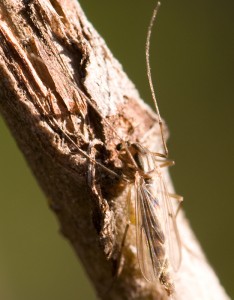
A female midge (family Chironomidae) at pHake Lake. The males have plumose antennae. ©Hartmut Wisch.
Whenever I hear “midges”, I think of the Fellowship of the Ring tromping through the Midgewater Marshes:
“I am being eaten alive,” cried Pippin. “Midgewater! There are more midges than water!”
“What do they live on when they can’t get hobbit?” said Sam, scratching his neck.The midges in the Lord of the Rings, however, can not have been Chironomidae, which are non-biting. These small flies, which are known in various parts of the US as “sand flies”, “muckleheads”, “muffleheads”, “blind mosquitoes”, or “chizzywinks”, resemble mosquitoes, but lack the elongated mosquito mouth parts. They occur worldwide, including Antarctica and the high Arctic islands. More than 1,000 species are found in North America.
Polytene chromosomes were first discovered in Chironomidae, and the number, morphology, and banding pattern of the polytene chromosomes are used in systematic studies of this family. Some researchers have also used abnormalities in Chironomidae polytene chromosomes as indicators of heavy metal pollution.
- Cream Grasshopper (Cibolacris parviceps)
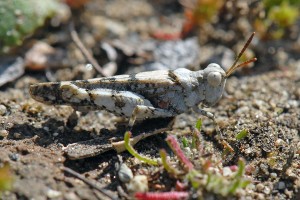
A male Cream Grasshopper, Cibolacris parviceps, in the path just west of the entry drive. ©Nancy Hamlett.
Cibolacris parviceps is a fairly small (2-3 cm) grasshopper of the desert southwest, ranging south from Nevada through Baja California and the Chihuahuan Desert of Mexico. It eats annual forbs and creosote bush.
- Melecta sp. (a cuckoo bee)
This bee was spotted on the island in pHake Lake hanging out on the ground near the entrances to Anthophora pacifica burrows, which makes sense since Melecta is a nest parasite of Anthophora. It lays its eggs in Anthophora burrows, which the Anthophora have provisioned with nectar and pollen and in which they have laid their own eggs. The Melecta larvae hatch more quickly than the Anthophora larvae, and the first Melecta larva to hatch not only pierces the Anthophora egg and drains the contents, but also destroys any other Melecta eggs. It then consumes the nectar and pollen provisions. While most bees have scopa — specialized structures for pollen collection — Melecta does not, as it lets the Anthophora do all the pollen-collecting.
The Melecta we’ve spotted at the BFS are probably M. separata callura, but we need a specimen or more detailed photographs to confirm the species. If you’re interested in more details, Robin Thorps’s article, Ecology and Behavior of Melecta separata callura (Hymenoptera: Anthophoridae) (Amer. Mid. Nat. 82: 338-345, 1969) is a fascinating read.
- Filacus sp. (a sawfly)
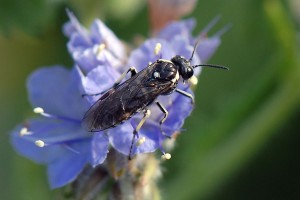
A sawfly, Filacus sp., on Phacelia distans just outside the fence along Foothill Blvd. ©Nancy Hamlett.
Sawflies are in the order Hymenoptera, along with ants, bees, and wasps. Their name comes from their saw-like ovipositors that they use to cut into plant tissues to deposit their eggs. They differ from other members of this order in having caterpillar-like larvae. There are four species of Filacus in this area, but it’s usually not possible to distinguish them from photographs. The adults visit Phacelia and other flowers, and the larvae of at least one species also feed on Phacelia.
- Andrena sp. (a mining bee)
These little bees (6-7 mm) were seen nectaring on Phacelia distans in the area west of the infirmary, just south of Blaisdell Ave. They may be Andrena palpalis, a Phacelia specialist, but we will probably need a specimen to confirm the ID.
-
Water Striders, family Gerridae
Prof. Cathy McFadden spotted water striders in the new toad pond. Water Striders have hairs on the underside of the tarsi that enable them to walk on the water’s surface. We don’t have any photos from the BFS yet, but you can see a bunch here. - Hiltonius pulchrus (a spirobolid millipede)
We have been puzzled in the past as to whether the large spirobolid millipedes seen at the BFS were Hiltonius pulchrus or Tylobolus claremontus. Subsequently Prof. Jonathan Wright definitively identified T. claremontus at the BFS, but now this spring’s Pomona Biology 41E class pit-trapped H. pulchrus. So we have both species at the BFS! Unfortunately, we cannot tell which of the two are pictured in our current photos, but we hope to get photos showing the defining characteristics soon.
